Ielts academic Reading 63
Question 34-39
Answer the questions below with words taken from Reading Passage 63.
Use NO MORE THAN TWO WORDS for each answer
34. According to the writers, what might the use of spices in cooking help people to avoid?
a) .
35. What proportion of bacteria in food do four of the spices tested destroy?
a) .
36. Which food often contains a spice known as ‘quatre epices’?
a) .
37. Which types of country use the fewest number of spices in cooking?
a) .
38. What might food aversions often be associated with?
a) .
39. Apart from spices, which substance is used in all countries to preserve food?
a) .
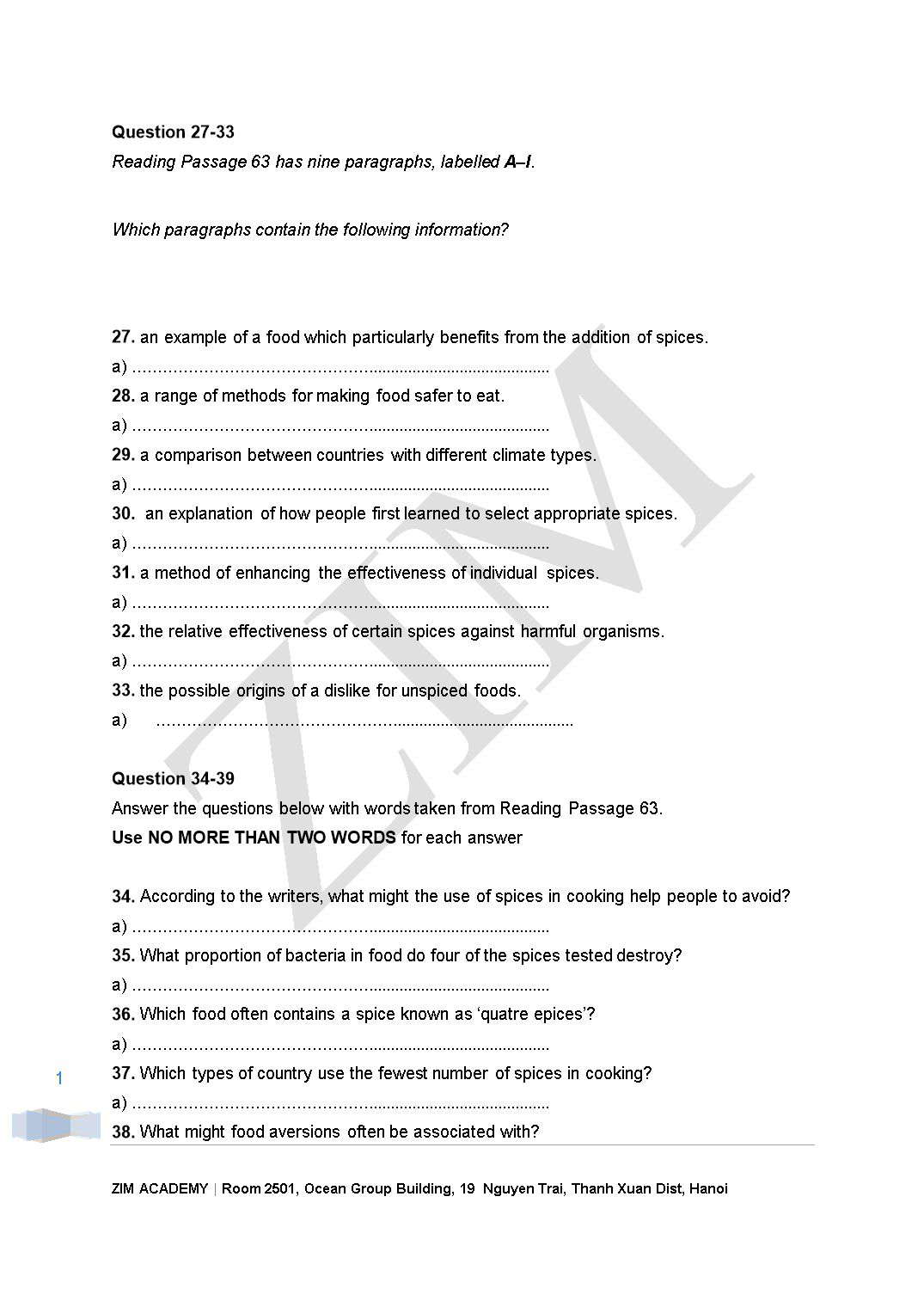
Trang 1
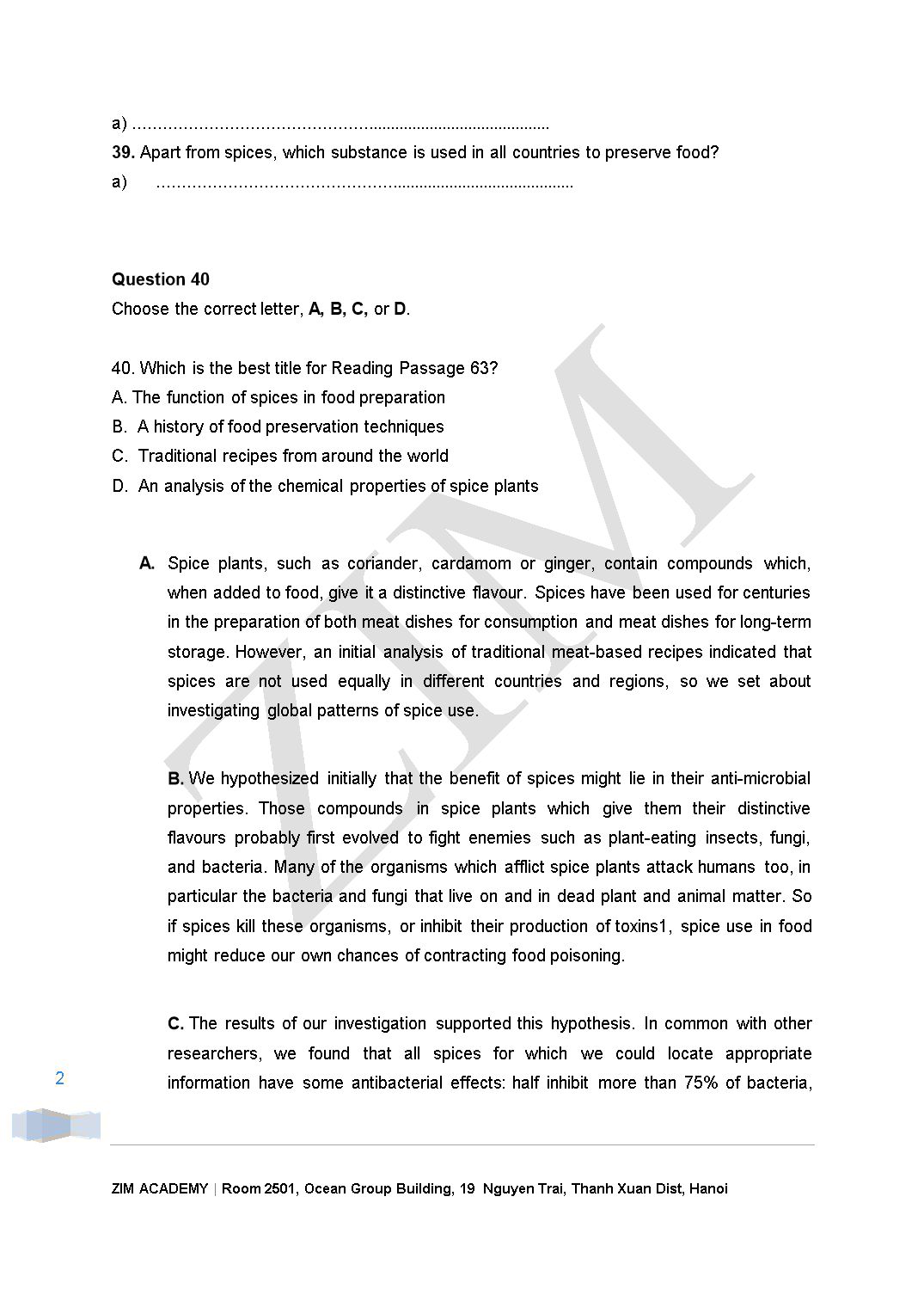
Trang 2
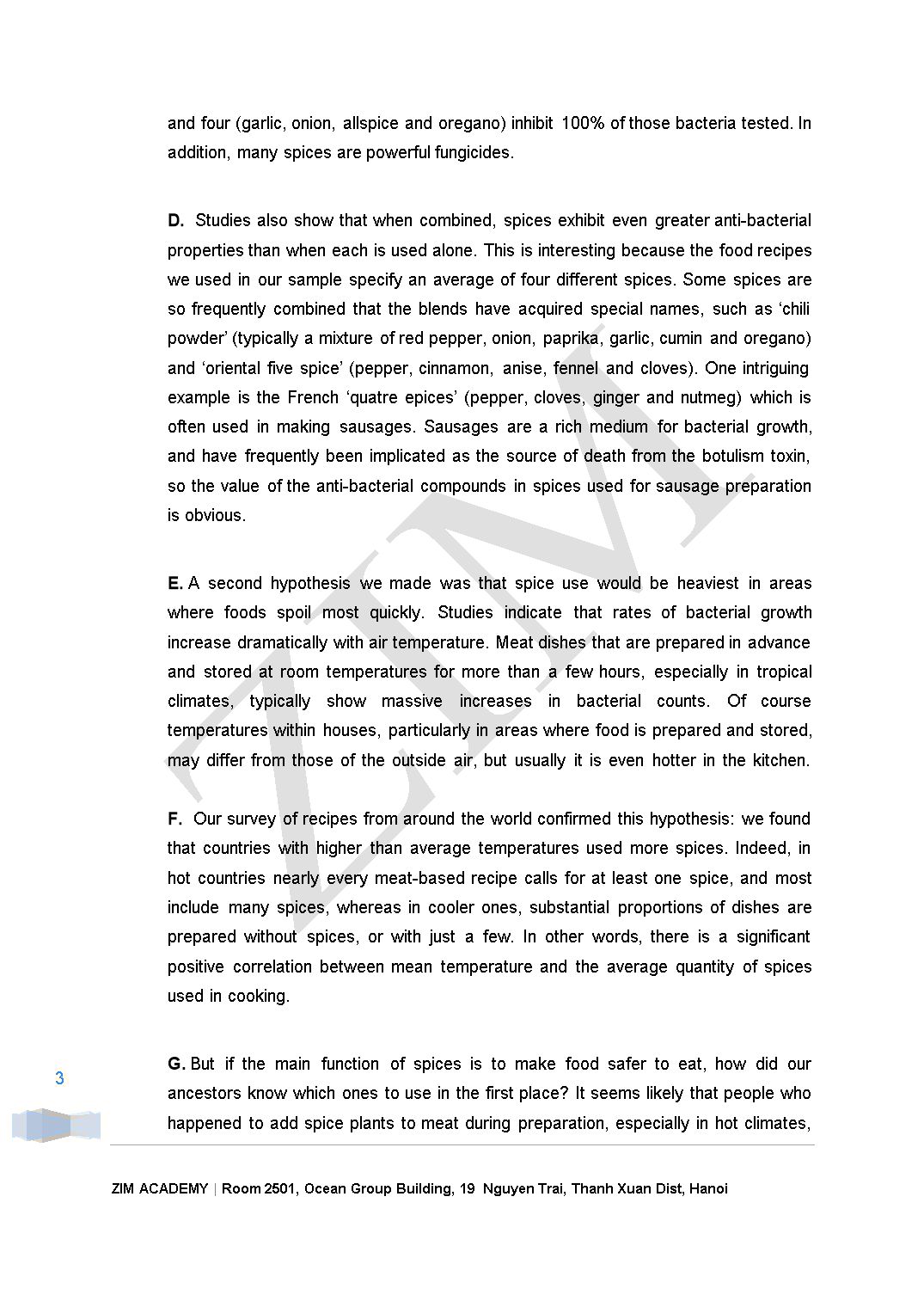
Trang 3
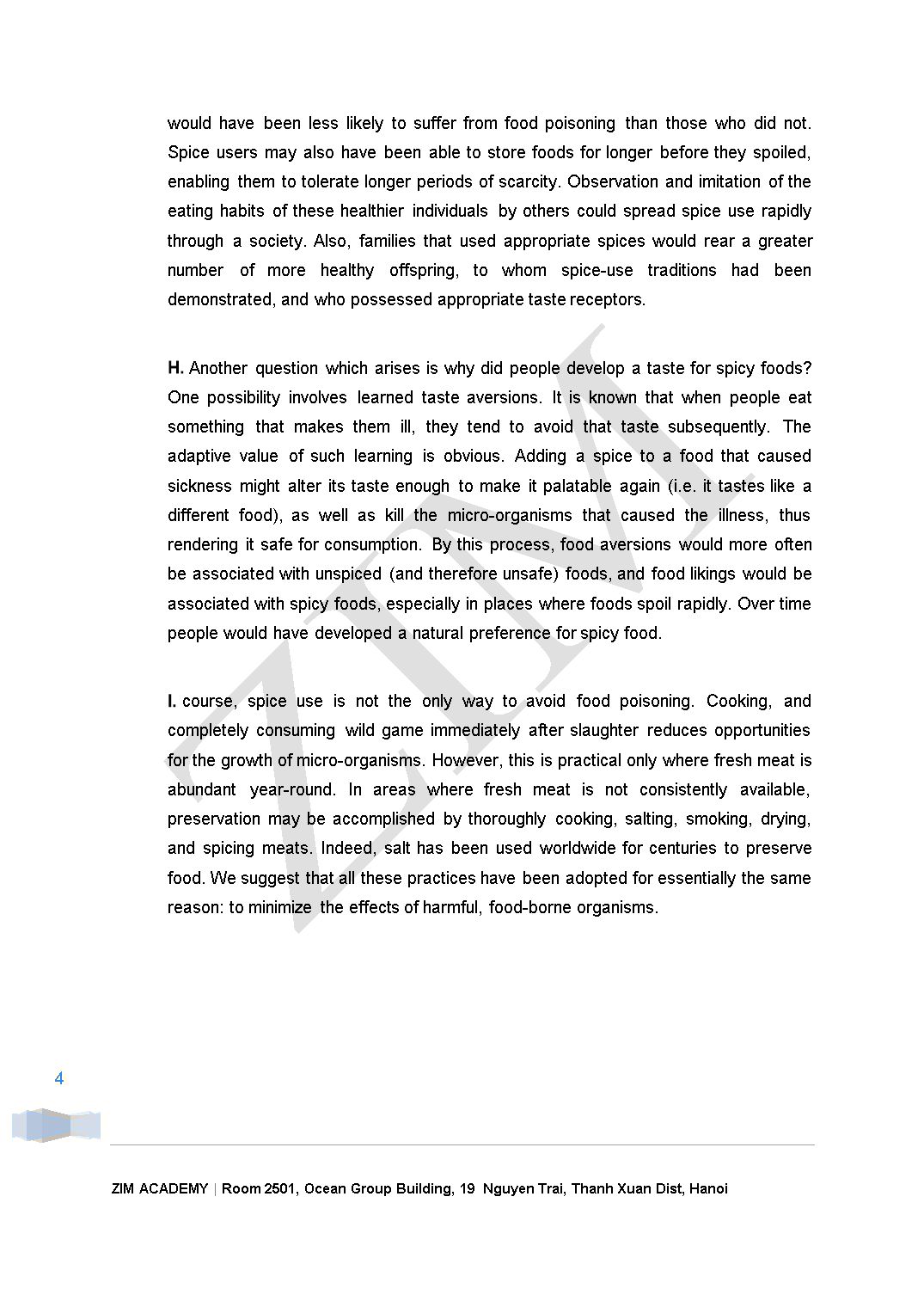
Trang 4
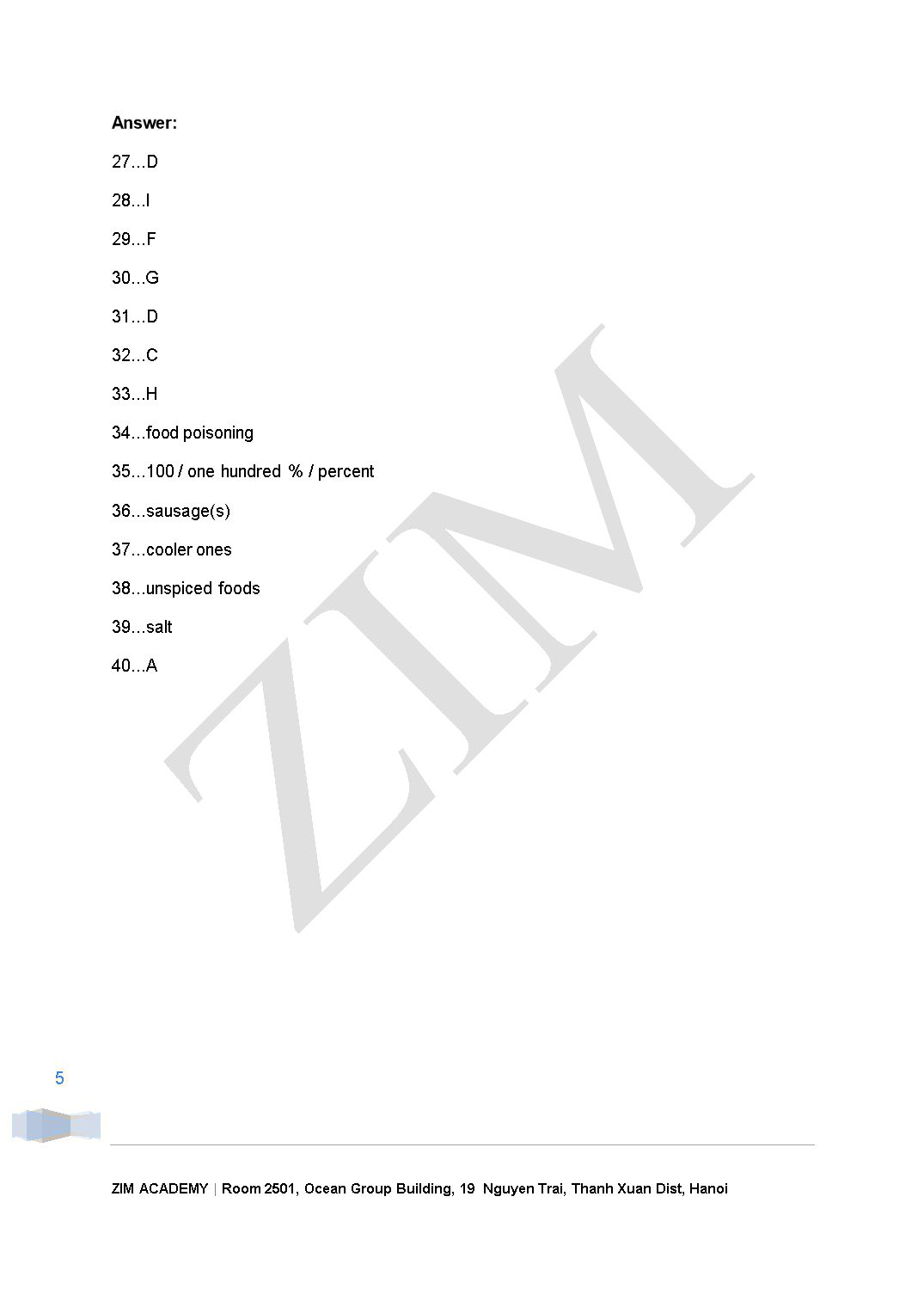
Trang 5
Bạn đang xem tài liệu "Ielts academic Reading 63", để tải tài liệu gốc về máy hãy click vào nút Download ở trên
Tóm tắt nội dung tài liệu: Ielts academic Reading 63
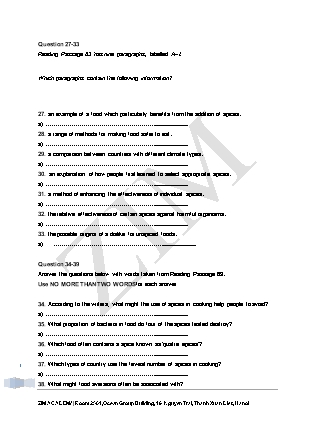
Question 27-33 Reading Passage 63 has nine paragraphs, labelled A–I. Which paragraphs contain the following information? 27. an example of a food which particularly benefits from the addition of spices. a) ........................................................................................ 28. a range of methods for making food safer to eat. a) ........................................................................................ 29. a comparison between countries with different climate types. a) ........................................................................................ 30. an explanation of how people first learned to select appropriate spices. a) ........................................................................................ 31. a method of enhancing the effectiveness of individual spices. a) ........................................................................................ 32. the relative effectiveness of certain spices against harmful organisms. a) ........................................................................................ 33. the possible origins of a dislike for unspiced foods. a) ........................................................................................ Question 34-39 Answer the questions below with words taken from Reading Passage 63. Use NO MORE THAN TWO WORDS for each answer 34. According to the writers, what might the use of spices in cooking help people to avoid? a) ........................................................................................ 35. What proportion of bacteria in food do four of the spices tested destroy? a) ........................................................................................ 36. Which food often contains a spice known as ‘quatre epices’? a) ........................................................................................ 37. Which types of country use the fewest number of spices in cooking? a) ........................................................................................ 38. What might food aversions often be associated with? a) ........................................................................................ 39. Apart from spices, which substance is used in all countries to preserve food? a) ........................................................................................ Question 40 Choose the correct letter, A, B, C, or D. 40. Which is the best title for Reading Passage 63? A. The function of spices in food preparation B. A history of food preservation techniques C. Traditional recipes from around the world D. An analysis of the chemical properties of spice plants Spice plants, such as coriander, cardamom or ginger, contain compounds which, when added to food, give it a distinctive flavour. Spices have been used for centuries in the preparation of both meat dishes for consumption and meat dishes for long-term storage. However, an initial analysis of traditional meat-based recipes indicated that spices are not used equally in different countries and regions, so we set about investigating global patterns of spice use. B. We hypothesized initially that the benefit of spices might lie in their anti-microbial properties. Those compounds in spice plants which give them their distinctive flavours probably first evolved to fight enemies such as plant-eating insects, fungi, and bacteria. Many of the organisms which afflict spice plants attack humans too, in particular the bacteria and fungi that live on and in dead plant and animal matter. So if spices kill these organisms, or inhibit their production of toxins1, spice use in food might reduce our own chances of contracting food poisoning. C. The results of our investigation supported this hypothesis. In common with other researchers, we found that all spices for which we could locate appropriate information have some antibacterial effects: half inhibit more than 75% of bacteria, and four (garlic, onion, allspice and oregano) inhibit 100% of those bacteria tested. In addition, many spices are powerful fungicides. D. Studies also show that when combined, spices exhibit even greater anti-bacterial properties than when each is used alone. This is interesting because the food recipes we used in our sample specify an average of four different spices. Some spices are so frequently combined that the blends have acquired special names, such as ‘chili powder’ (typically a mixture of red pepper, onion, paprika, garlic, cumin and oregano) and ‘oriental five spice’ (pepper, cinnamon, anise, fennel and cloves). One intriguing example is the French ‘quatre epices’ (pepper, cloves, ginger and nutmeg) which is often used in making sausages. Sausages are a rich medium for bacterial growth, and have frequently been implicated as the source of death from the botulism toxin, so the value of the anti-bacterial compounds in spices used for sausage preparation is obvious. E. A second hypothesis we made was that spice use would be heaviest in areas where foods spoil most quickly. Studies indicate that rates of bacterial growth increase dramatically with air temperature. Meat dishes that are prepared in advance and stored at room temperatures for more than a few hours, especially in tropical climates, typically show massive increases in bacterial counts. Of course temperatures within houses, particularly in areas where food is prepared and stored, may differ from those of the outside air, but usually it is even hotter in the kitchen. F. Our survey of recipes from around the world confirmed this hypothesis: we found that countries with higher than average temperatures used more spices. Indeed, in hot countries nearly every meat-based recipe calls for at least one spice, and most include many spices, whereas in cooler ones, substantial proportions of dishes are prepared without spices, or with just a few. In other words, there is a significant positive correlation between mean temperature and the average quantity of spices used in cooking. G. But if the main function of spices is to make food safer to eat, how did our ancestors know which ones to use in the first place? It seems likely that people who happened to add spice plants to meat during preparation, especially in hot climates, would have been less likely to suffer from food poisoning than those who did not. Spice users may also have been able to store foods for longer before they spoiled, enabling them to tolerate longer periods of scarcity. Observation and imitation of the eating habits of these healthier individuals by others could spread spice use rapidly through a society. Also, families that used appropriate spices would rear a greater number of more healthy offspring, to whom spice-use traditions had been demonstrated, and who possessed appropriate taste receptors. H. Another question which arises is why did people develop a taste for spicy foods? One possibility involves learned taste aversions. It is known that when people eat something that makes them ill, they tend to avoid that taste subsequently. The adaptive value of such learning is obvious. Adding a spice to a food that caused sickness might alter its taste enough to make it palatable again (i.e. it tastes like a different food), as well as kill the micro-organisms that caused the illness, thus rendering it safe for consumption. By this process, food aversions would more often be associated with unspiced (and therefore unsafe) foods, and food likings would be associated with spicy foods, especially in places where foods spoil rapidly. Over time people would have developed a natural preference for spicy food. I. course, spice use is not the only way to avoid food poisoning. Cooking, and completely consuming wild game immediately after slaughter reduces opportunities for the growth of micro-organisms. However, this is practical only where fresh meat is abundant year-round. In areas where fresh meat is not consistently available, preservation may be accomplished by thoroughly cooking, salting, smoking, drying, and spicing meats. Indeed, salt has been used worldwide for centuries to preserve food. We suggest that all these practices have been adopted for essentially the same reason: to minimize the effects of harmful, food-borne organisms. Answer: 27...D 28...I 29...F 30...G 31...D 32...C 33...H 34...food poisoning 35...100 / one hundred % / percent 36...sausage(s) 37...cooler ones 38...unspiced foods 39...salt 40...A
File đính kèm:
 ielts_academic_reading_63.doc
ielts_academic_reading_63.doc

